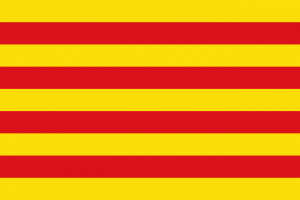Language/Catalan/Vocabulary/Telling-Time
| ◀️ Numbers 1-100 — Previous Lesson | Next Lesson — Adjective Agreement ▶️ |
Introduction[edit | edit source]
Welcome to the lesson on telling time in Catalan! In this lesson, we will explore the vocabulary and phrases necessary to discuss hours, minutes, and time-related expressions in Catalan. Telling time is an essential skill in any language, as it allows us to organize our daily activities and communicate effectively with others. By the end of this lesson, you will be able to confidently tell the time in Catalan and engage in conversations about past, present, and future events. So let's dive in and learn how to tell time in Catalan!
Table of Contents[edit | edit source]
Vocabulary[edit | edit source]
Before we start learning how to tell time, let's familiarize ourselves with some key vocabulary related to time in Catalan. Here are a few essential words and phrases you'll need to know:
| Catalan | Pronunciation | English |
|---|---|---|
| l'hora | law-rah | the hour |
| el minut | el mee-NOOT | the minute |
| el rellotge | el reh-YOT-jeh | the clock |
| la tarda | lah TAR-dah | the afternoon |
| la nit | lah neet | the night |
| migdia | meed-YAH | noon |
| mitjanit | meet-yah-NEET | midnight |
Telling the Hours[edit | edit source]
Now that we know some basic vocabulary, let's learn how to tell the hours in Catalan. The structure to express the time in Catalan is:
"Hora" + "number" + "en punt"
Here are a few examples:
- L'hora és la una en punt. (The time is one o'clock.)
- L'hora és la sis en punt. (The time is six o'clock.)
- L'hora és la dotze en punt. (The time is twelve o'clock.)
Notice that when the hour is "una" (one), we use "és" (is) instead of "són" (are). This is because "una" is singular, while the other numbers are plural.
Telling the Minutes[edit | edit source]
In addition to the hours, it's important to know how to tell the minutes in Catalan. To express the minutes, we use the following structure:
"Number" + "minuts"
Here are a few examples:
- L'hora és la una i deu minuts. (The time is ten past one.)
- L'hora és la sis i vint minuts. (The time is twenty past six.)
- L'hora és la dotze i cinc minuts. (The time is five past twelve.)
Notice that when the minutes are between "una" (one) and "nou" (nine), we use "i" (and) to connect the hour and minutes.
Phrases for Past, Present, and Future Events[edit | edit source]
Now that we know how to tell the time, let's learn some phrases to discuss past, present, and future events in Catalan. Here are a few useful expressions:
- Ahir a les quatre. (Yesterday at four o'clock.)
- Avui al migdia. (Today at noon.)
- Demà a les vuit. (Tomorrow at eight o'clock.)
- La setmana passada a les deu. (Last week at ten o'clock.)
- El mes que ve a les tres. (Next month at three o'clock.)
These phrases will help you navigate conversations about specific times and events in Catalan.
Cultural Insights[edit | edit source]
In Catalan-speaking regions, time is an important aspect of daily life. Punctuality is highly valued, and it is considered impolite to be late for appointments or meetings. Therefore, it's essential to be able to tell the time accurately and communicate your availability effectively.
Catalan is spoken in several regions, including Catalonia, Valencia, and the Balearic Islands. While the basic vocabulary and structure for telling time remain the same across these areas, there might be slight variations in pronunciation or regional expressions. For example, in Valencia, it is common to use "la vesprada" instead of "la tarda" to refer to the afternoon. Similarly, in the Balearic Islands, "la nit" can be replaced by "sa nit." These regional differences add richness to the Catalan language and reflect the cultural diversity within the Catalan-speaking community.
Practice Exercises[edit | edit source]
Now it's time to put your knowledge into practice! Here are a few exercises to help you reinforce what you've learned:
Exercise 1: Write the following times in Catalan: 1. 9:30 AM 2. 5:45 PM 3. 11:15 PM
Exercise 2: Translate the following phrases into Catalan: 1. Yesterday at three o'clock. 2. Today at nine o'clock. 3. Tomorrow at six o'clock.
Exercise 3: Fill in the blanks with the correct time: 1. L'hora és _________ en punt. 2. L'hora és _________ i cinc minuts. 3. L'hora és _________ i vint minuts.
Exercise Solutions[edit | edit source]
Exercise 1: 1. L'hora és les nou i mitja del matí. 2. L'hora és les cinc i quaranta-cinc de la tarda. 3. L'hora és les onze i quinze de la nit.
Exercise 2: 1. Ahir a les tres en punt. 2. Avui a les nou en punt. 3. Demà a les sis en punt.
Exercise 3: 1. L'hora és la una 2. L'hora és les cinc 3. L'hora és les dotze
Conclusion[edit | edit source]
Congratulations! You have successfully learned how to tell time in Catalan. Remember to practice regularly to improve your skills and fluency. Being able to tell time accurately is an essential skill that will help you in your daily life and interactions with others. Keep up the good work and continue exploring the fascinating world of the Catalan language and culture!
Sources[edit | edit source]
- Catalan Tutorial: Basic Catalan Phrases, Vocabulary, and Grammar
- Catalan - Definition, Meaning & Synonyms | Vocabulary.com
- Is Catalan hard or easy to learn? (It depends.) - Relearn A Language
Other Lessons[edit | edit source]
- Languages
- Prepositions in Catalan
- Literary and academic vocabulary
- Computer
- Greetings
- City
- Food
- At the Restaurant
- Useful Expression in Catalan
- Family Members
| ◀️ Numbers 1-100 — Previous Lesson | Next Lesson — Adjective Agreement ▶️ |

